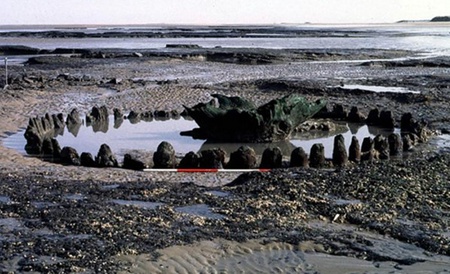New research into an ancient timber circle discovered on a Norfolk beach and dubbed 'Seahenge' suggests it was created in response to a period of extreme climatic deterioration at the close of the third millennium BC.
University of Aberdeen researcher Dr David Nance has published new findings in GeoJournal on Holme I – a 4000-year-old Bronze Age timber circle revealed by the shifting sands of Holme-next-the-sea beach on the north Norfolk coast in 1998.
The circle, consisting of an upturned tree-stump surrounded by 55 closely fitted oak posts, was originally built on the saltmarsh away from the sea and specialists estimate it to have been built of timbers dating from the spring of 2049 BC.
It would have been positioned in an area protected from the sea by sand dunes and mud flats. This swampy area created a layer of peat which slowly covered the timbers, protecting them from decay.
Dr Nance also looked at Holme II – a second, adjacent ring dated to the same year centred on two oak logs laid flat.
He considered the archaeology of the sites together with climatic and environmental data, astronomic and biological evidence, regional folklore and toponymy.
It has previously been suggested that the structures - the only known British monuments erected together – may have been erected to mark the death of an individual while others have suggested they were used for sky burials, where the dead would be placed inside to be pecked and carried away by carrion-eating birds.
Dr Nance puts forward an alternative explanation in his paper instead suggesting that Seahenge and the adjacent timber circle were constructed during a bitterly cold climatic period for rituals intended to extend the summer and the return of warmer weather.
Dr Nance explains: “Dating of the Seahenge timbers showed they were felled in the spring, and it was considered most probable that these timbers were aligned with sunrise on the summer solstice.
“We know that the period in which they were constructed 4,000 years ago was a prolonged period of decreased atmospheric temperatures and severe winters and late springs placing these early coastal societies under stress.
“It seems most likely that these monuments had the common intention to end this existential threat but they had different functions.”
He points to the alignment of Seahenge with sunrise on the summer solstice and suggests that its function was to mimic the ‘pen’ described in folklore for an unfledged cuckoo with the intention to keep the bird singing and thereby extend the summer.
“Summer solstice was the date when according to folklore the cuckoo, symbolising fertility, traditionally stopped singing, returned to the Otherworld and the summer went with it,’ Dr Nance added.
“The monument’s form appears to imitate two supposed winter dwellings of the cuckoo remembered in folklore: a hollow tree or ‘the bowers of the Otherworld’ represented by the upturned oak-stump at its centre.
“This ritual is remembered in the ‘myth of the pent cuckoo’ where an unfledged cuckoo was placed into a thorn bush and the bird was ‘walled-in’ to extend the summer but it always flew away.”
For Holme II he points to legends of ‘sacred kings’ described in Iron Age Ireland and northern Britain who were sacrificed if misfortune fell on the community, as happened at Holme-next-the-sea, in an attempt to appease the goddess of Venus to restore harmony.
He said: “Evidence suggests that they were ritually-sacrificed every eight years at Samhain (now Halloween) coincident with the eight-year cycle of Venus.
“The fixtures in Holme II that were thought to hold a coffin, are orientated towards sunrise on Samhain in 2049 when Venus was still visible.
“Both monuments are best explained as having different functions and associated rituals, but with a common intent: to end the severely cold weather.”


